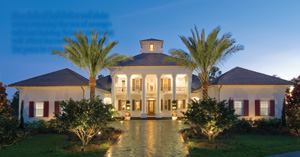While CFLs dramatically reduce the amount of energy consumed, they introduce environmental issues of their own due to the small amounts of mercury inside. As a result, they need to be disposed of in accordance with local environmental regulations. The GE Web site instructs consumers not to throw CFLs away in household garbage (never in an incinerator) “if better disposal options exist” and refers consumers to a toll-free number for disposal options. It also gives detailed instructions for cleanup if consumers break a CFL in the home, including sweeping (not vacuuming) the broken bulb, sealing it in plastic and opening windows for ventilation.
With so many caveats to CFL, there’s a drive for better green lighting options. The 2012 deadline is a long way away and with development time on its side, the lighting industry is sure to respond to the energy-conscious world with products that meet the aesthetic needs of architects, designers, and homeowners. “Lighting sources such as LEDs and compact fluorescents have captured the market’s interest, leading to future product developments,” says Black of Lutron. Meshberg of Genlyte says, “Lamp manufacturers are working hard on high-efficiency incandescent sources to add to the 2012 mandate.”
Halogens, too, can fit the high-efficiency profile. They use less energy than incandescents and when dimmed 10 percent with a standard dimmer, a halogen bulb can double its life. Dim at 30 percent to 40 percent and you extend the life by thousands of hours. “CFLs have a life of 10,000 hours,” Meshberg says. “I can get 10,000 hours out of a halogen if I dim it.”
What else is in the technology pipeline? LED, whose 100,000-hour bulbs could outlive their owners. “LEDs are coming on big time,” Meshberg says. “Within the next year we’ll start to see a lot of it.” The looming challenges for LEDs include bringing down fixture costs and meeting consumer expectations. “They’re trying to come up with white light that matches what people are used to,” Meshberg says. “The hard part is getting consistent light from bulb to bulb.” Issues also exist with production yields and flickering during dimming. “Control of LEDs still needs work” Meshberg says, “but expect major breakthroughs with white light LED in the next 12 to 24 months.”
Meantime, new products keep hitting the shelves and they’re getting greener all the time. Lutron’s latest Grafik Eye system controls both natural light through the Sivoia electronic shade system and room lighting. A readout on the front panel shows consumers how much energy they’re saving at different dim levels. Also, Lutron’s new Eco-Dim dimmers limit lighting levels to 85 percent of full capacity to conserve energy and extend bulb life. The dimmers work with incandescent and halogen bulbs.
One thing’s for sure: Lighting four years from now—CFL, halogen, incandescent, LED, and other types on the drawing board—will look very different from what we have today. Says Meshberg: “The charge is on for 2012.”—Rebecca Day specializes in writing about home electronics. She can be reached at customhomerd@aol.com.



